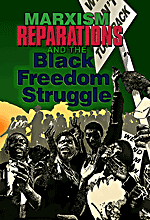

“Marxism, Reparations and the Black Freedom Struggle” is available in free download from workers.org/books.
In the Civil War’s closing days, Union Army forces finally defeated the Confederate hold on Atlanta in fall of 1864. An economic citadel of the racist system of enslavement, almost half the city was burned by federal troops.
“Marxism, Reparations and the Black Freedom Struggle” is available in free download from workers.org/books.
In November, a week after the reelection of President Abraham Lincoln and under a cloud of smoke, the Union Army departed for what became the historic “March to the Sea.” Led by General William Sherman, troops headed 285 miles through the plantations of the slavocracy to reach the sea at Savannah, Georgia.
This was an Emancipation March of 60,000 troops, many of them Black troops, along with an almost equal number of emancipated Black people and refugees of war.
This great throng was out to destroy enslavement. They marched over a front between 25 and 60 miles wide, through some of the wealthiest and most productive plantations in the country.
The land had been stolen by European and then American settler colonists from the Southeast Indigenous nations, through centuries of forced displacement and genocide. By the late 18th century, the white owning class that arose there bought and sold Black people and became fabulously wealthy by profits from the unwaged labor of enslaved people. They had forcibly removed the Southeast Native nations to the West in the Trail of Tears in the 1830s.
The mass of humanity moved toward the sea at a pace of 15 miles a day. With no supply line, they had to live off the land. The property of the enslavers was taken for survival. The marchers feasted on crops and livestock — food denied to them during enslavement. The rail lines used to transport the crops and cotton cultivated with their forced labor were torn up. Steel ties were thrown on bonfires, heated up and wrapped around tree trunks.
This awesome amount of destruction amounted to the “trampling out the vintage, where the grapes of wrath are stored” — a line from the 1862 “Battle Hymn of the Republic.” Sherman’s March to the Sea was made to break the back of racist enslavers’ power both economically and politically — an absolute necessity for Emancipation and the establishment of the beginning of access to democratic rights for all Black people in the U.S.
When the army came to Savannah in mid-December, the Confederacy had another four months to live before Robert E. Lee’s surrender in Virginia.
According to the Freedman and Southern Society Project, 20 Black men, most of them formerly enslaved, met on Jan. 12, 1865, to discuss the economic future of 4 million freed people.
Before General Sherman and Secretary of War Edwin Stanton, their spokesperson Garrison Frazier stated, “The way we can best take care of ourselves is to have land and turn it and till it by our own labor . . . and we can soon maintain ourselves and have something to spare.” (www.freedmen.umd.edu/savmtg.htm)
This discussion with the Black community became the basis for Sherman’s Special Field Order 15 issued on Jan. 16, 1865. The Field Order stated that the land on the coastline stretching from Charleston, South Carolina, down the Georgia coast to Jacksonville, Florida, including the Sea Islands and the mainland 30 miles in from the coast, was to be turned over to the freed people of African descent.
The total amounted to 400,000 acres confiscated during the war from white land owners. The order stated that “each family shall have no more than 40 acres of tillable ground . . . until Congress shall regulate their title.”
This order was enacted, and soon some of the richest planter land was settled by newly freed Black people. This opened the possibility that a transformation of society even more radical than the end of enslavement could be at hand.
The heroic struggle of Black working people after the Civil War is analyzed in the groundbreaking work by W.E.B. Du Bois, “Black Reconstruction in America 1860-1880.” See also Monica Moorehead, “Black farmers still seek justice,” Workers World, July 18, 2002, and “Marxism, Reparations and the Black Freedom Struggle” (2007), on Black people fighting to retain freedom and land into the 21st century.
In its ongoing genocidal campaign against the Palestinian people, Israel used drones May 2 to…
Palestinian and regional factions condemned the Israel Occupation Forces’ attack today on the Al-Dameer (Conscience)…
A message for May Day: ‘Workers of the world unite, Palestine is our fight!’ International…
Africa is rising, the days of colonialism are finished: This is the call being echoed…
Several immigrant groups and their supporters rallied outside the federal courthouse in Philadelphia on May…
Thousands of construction workers and teachers in at least seven provinces throughout Panamá took to…